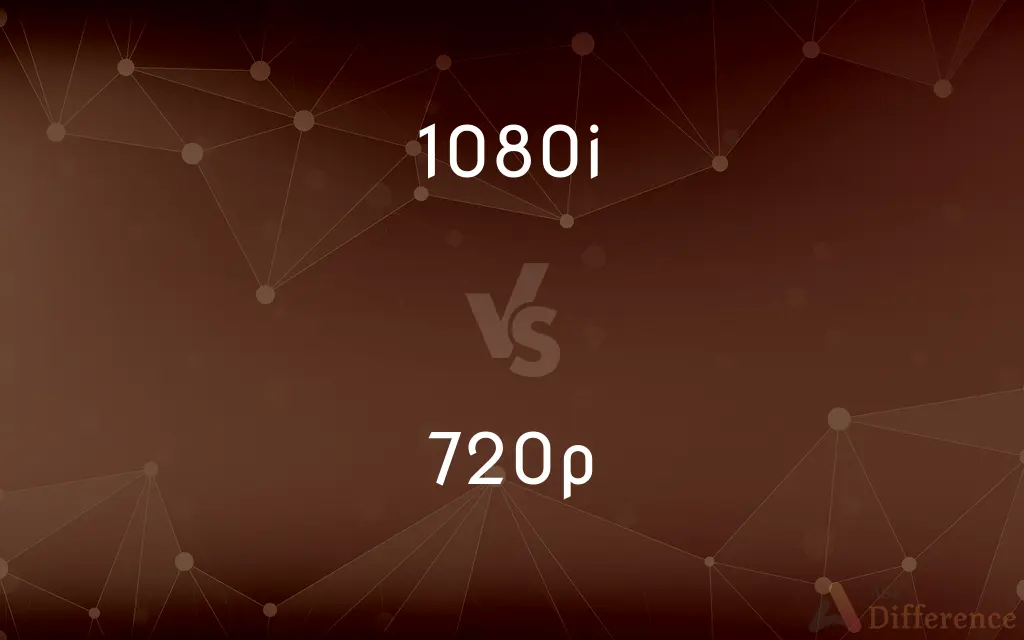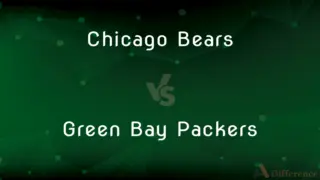1080i vs. 720p — What's the Difference?
By Tayyaba Rehman & Urooj Arif — Published on February 14, 2024
1080i provides higher resolution with interlaced scanning, while 720p offers lower resolution with progressive scanning, resulting in smoother motion.

Difference Between 1080i and 720p
Table of Contents
ADVERTISEMENT
Key Differences
1080i and 720p represent two different methods of displaying images on a television or monitor, each with its unique characteristics and advantages. 1080i stands for 1080 interlaced lines of resolution, meaning the image is displayed in two fields: one for odd lines and one for even lines, effectively interlacing them. This method can lead to a perceived increase in resolution, especially for static images, due to its higher line count. However, because the fields are displayed alternately, fast-moving images may appear blurred or have a "combing" effect.
On the other hand, 720p represents 720 progressive lines of resolution, where "p" stands for progressive scan. Unlike 1080i, 720p displays all lines of the image in sequence, which can greatly reduce motion blur and provide a smoother image for fast-moving content. While 720p has fewer lines of resolution compared to 1080i, the continuous display of images makes it better suited for sports, action movies, and video games where motion clarity is critical.
The choice between 1080i and 720p often depends on the type of content being viewed. For instance, 1080i might be preferred for watching high-definition broadcast television and detailed static images due to its higher resolution. Meanwhile, 720p could be the preferred choice for digital platforms and content that involves a lot of movement, benefiting from the smoother presentation offered by progressive scanning.
Another consideration is the compatibility with the display device. Some older HDTVs and monitors might not support 1080p (the progressive version of 1080), making 1080i a better high-resolution option. However, modern TVs and monitors typically support both 1080p and 720p, allowing users to choose based on preference or content type without worrying about compatibility issues.
In summary, 1080i and 720p cater to different viewing needs, with the former offering higher resolution ideal for static images and the latter providing smoother motion for dynamic content. Understanding the strengths of each format can help viewers optimize their viewing experience based on the content they enjoy most.
ADVERTISEMENT
Comparison Chart
Resolution
1920x1080 pixels
1280x720 pixels
Scanning Method
Interlaced
Progressive
Image Clarity
Higher for static images
Higher for moving images
Motion Blur
More noticeable in fast-moving scenes
Less motion blur
Best Used For
Broadcast HD TV, static images
Sports, action movies, video games
Compare with Definitions
1080i
A high-definition video format with interlaced scanning.
The nature documentary looked crisp and detailed in 1080i.
720p
Provides a consistent image quality for moving scenes.
The car chase scenes were crystal clear in 720p resolution.
1080i
Can cause motion artifacts in fast-moving scenes.
Fast-paced sports events sometimes show combing effects in 1080i.
720p
Reduces motion blur, ideal for dynamic content.
Action movies look best in 720p due to the reduced blur.
1080i
Suited for content with less motion due to its interlacing effect.
Dramas and news programs are ideally watched in 1080i format.
720p
A high-definition video format with progressive scanning.
Watching the football game in 720p made the action appear smoother.
1080i
Typically used in broadcast television.
Most of the prime-time shows are broadcasted in 1080i.
720p
Displays 720 lines of resolution in sequence for smoother motion.
720p is my go-to for streaming fast-paced video games.
1080i
Offers 1080 lines of vertical resolution displayed alternately.
Broadcast TV channels often transmit in 1080i for higher resolution.
720p
Often preferred for digital platforms and live sports.
Most online streaming services use 720p for its smooth playback.
Common Curiosities
Do all modern TVs support both 1080i and 720p?
Yes, most modern TVs support both formats.
What does "i" in 1080i stand for?
Interlaced scanning.
What does "p" in 720p represent?
Progressive scanning.
Does 720p always provide smoother motion than 1080i?
Yes, due to its progressive scan method.
Which format is better for fast action movies?
720p, for its reduced motion blur.
Which is better for sports, 1080i or 720p?
720p, due to its smoother motion.
Can you notice the difference between 1080i and 720p on a small screen?
The difference is less noticeable on smaller screens.
Is 1080i higher resolution than 720p?
Yes, 1080i has more vertical lines of resolution.
Why do broadcasters use 1080i?
For its higher resolution with static images and compatibility with older TVs.
Which format is better for gaming, 1080i or 720p?
720p, for its smoother motion and reduced latency.
How do you choose between 1080i and 720p?
Base your choice on the type of content (static vs. motion) and your display device.
Do all digital devices automatically support 1080i and 720p?
Most modern digital devices support both, but always check the device specifications.
Can converting 1080i to 720p improve motion clarity?
Yes, converting to 720p can make fast-moving content appear smoother.
Which format uses more bandwidth, 1080i or 720p?
1080i, due to its higher resolution.
Are movies filmed in 1080i or 720p?
Movies are typically filmed in higher resolutions and then broadcast or streamed in various formats including 1080i and 720p.
Share Your Discovery

Previous Comparison
Scuba Diving vs. Snorkeling
Next Comparison
Chicago Bears vs. Green Bay PackersAuthor Spotlight
Written by
Tayyaba RehmanTayyaba Rehman is a distinguished writer, currently serving as a primary contributor to askdifference.com. As a researcher in semantics and etymology, Tayyaba's passion for the complexity of languages and their distinctions has found a perfect home on the platform. Tayyaba delves into the intricacies of language, distinguishing between commonly confused words and phrases, thereby providing clarity for readers worldwide.
Co-written by
Urooj ArifUrooj is a skilled content writer at Ask Difference, known for her exceptional ability to simplify complex topics into engaging and informative content. With a passion for research and a flair for clear, concise writing, she consistently delivers articles that resonate with our diverse audience.
















































